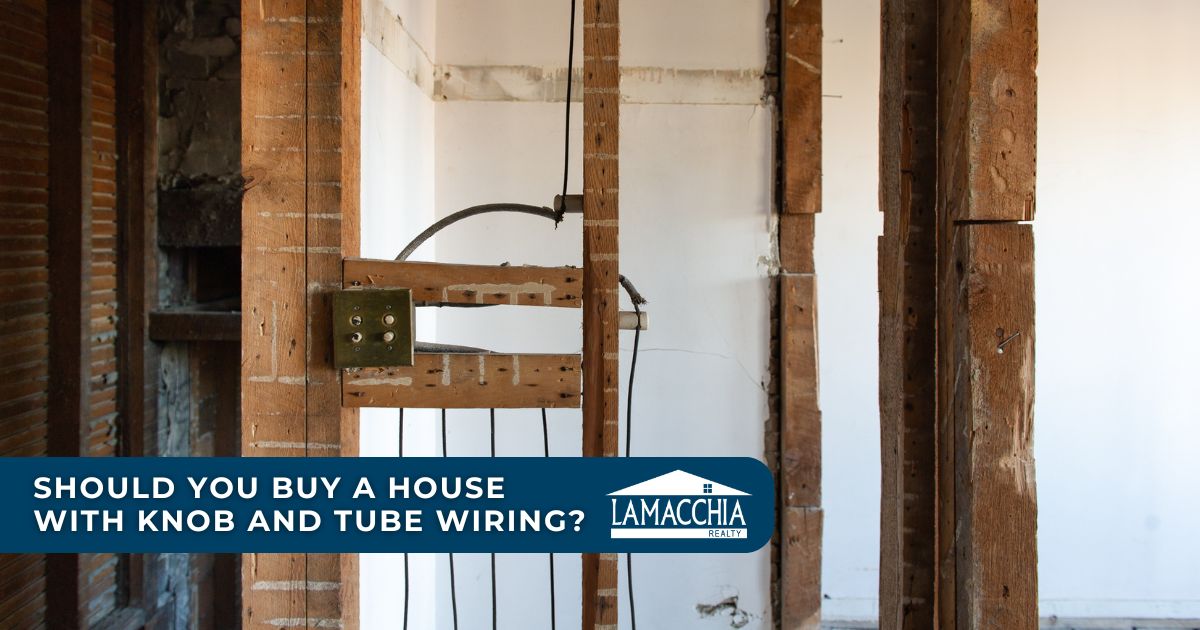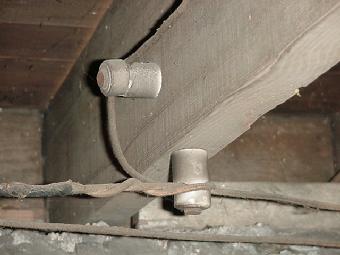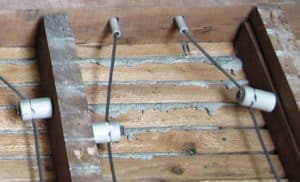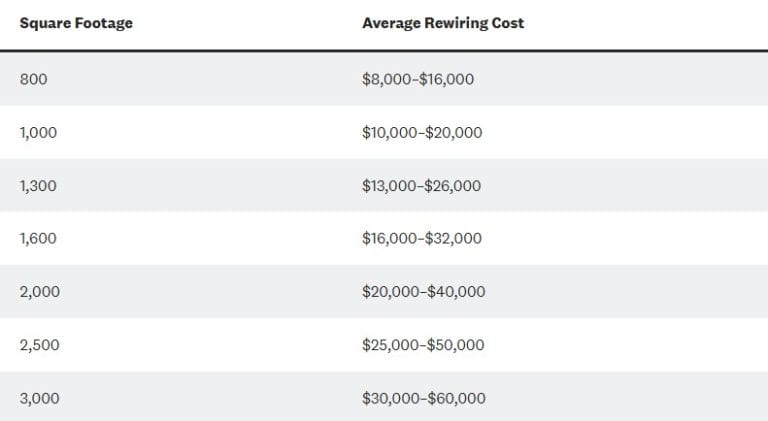
Buying a vintage home can certainly be exciting, as these houses boast a rich history and classic charm. However, many American homes built from the 1880s until about the mid-1950s still often have knob and tube electrical wiring original to the property. Knob and tube is a system of wiring where electrical wires anchored by ceramic insulating knobs pass through ceramic tubes placed inside holes drilled into the wooden joists of the house. If the house you have your heart set on has this type of wiring, you should have a good understanding of it and what implications may come with it, as it will likely need to be updated or replaced to obtain home insurance.
Is Knob and Tube Wiring Dangerous?
Many home buyers are uncertain of what their options are if they are interested in buying a house with knob and tube wiring. It’s important for homebuyers to understand that knob and tube wiring itself is not unsafe. In older homes where the wiring is functional, homeowners may not see many issues. In fact, the necessary drilling, soldering, wrapping, and splicing that was done during the original installation required a great deal of skill, since the wiring was meant to last for years to come.
However, knob and tube wiring is no longer used in homes because it doesn’t carry the same capacity for electricity that modern homes require. Modern households use much higher loads of electricity than the wiring was originally designed for, as the standard is now 60 amps. Homeowners should not install higher amp fuses to match the increase in electricity use as this will cause the wires to overheat. Knob and tube wiring, when not properly maintained, yields an increased risk of shock or fires.
At the end of the day, it’s fine to purchase a home that has knob and tube wiring, but you need to understand exactly how to deal with it, as it can pose challenges with home insurance and financing.
Getting Insurance for a Home with Knob and Tube Wiring
Obtaining insurance for a home with knob and tube wiring comes with a specific set of requirements. You must hire an electrician and submit to your insurance agent a contract stating that the knob and tube wiring will be replaced within the next 60 days of applying. Once the job is complete, a receipt indicating completion must be submitted. It’s important to note that if the wiring is not able to be replaced within that timeframe, you risk not being able to obtain home insurance. Without home insurance, you risk not getting qualified for a mortgage.
If home buyers can’t take it out or are unable to do it within the 60-day time frame, they can still potentially get insurance through the Massachusetts Property Insurance Underwriting Association (MPIUA). The MPIUA provides basic property insurance on eligible property for applicants who have been unable to gain insurance through the voluntary market. Keep in mind rates for MPIUA tend to be higher (between 30-60%) than a standard insurance company in Massachusetts. They will come out and do an inspection prior to coverage, but the inspection is free of charge.
Financing a Home with Knob and Tube Wiring
The Department of Housing and Urban Development (HUD) states that home appraisers should examine the electrical box to ensure there are no broken or frayed wires. Major selling guides such as Fannie Mae, Freddie Mac, and FHA will permit knob and tube wiring as long as it functions properly, is safe, in good condition, and is a minimum of 60 amps.
Is Buying a House with Knob and Tube Wiring Right for You?

When you are buying a home with knob and tube wiring, there are a few issues to be aware of. For instance, insulation cannot touch the wires, as the heat from the wires cannot dissipate. Knob and tube wiring does not provide a third wire for grounding, only a hot wire, and a neutral white wire. Even if two-slot outlets are replaced with three-prong outlets (for devices that require them, such as kitchen appliances) there is still no third wire which protects against electric shock.
One of the most common issues with knob and tube wiring is incorrect modifications. Because it is easily accessible, some homeowners make their own repairs and do not splice the wire correctly and they make inadequate, unsafe modifications.
Replacing Knob and Tube Wiring
Only qualified, licensed electricians should inspect and replace the wiring in your home. The wiring can be found in your attic, beneath the floorboards in the basement, and inside the walls of the home. It’s also detectable in the circuit box, but even with the power off, the wires can be live and potentially fatal to the touch. Once a professional can inspect the wiring, they’ll devise a plan and quote to bring your electrical up to code. The original wiring does not need to be removed. To do so involves additional time and money without any real benefit; it won’t be connected to a power source once the new wiring is installed and will therefore no longer pose a threat. This can be an expensive process but will save overall in potential hazards as well as higher home insurance premiums through the MPIUA.
Cost to Replace Knob and Tube Wiring in a Home
Replacing knob and tube wiring can be a costly project, making it absolutely crucial for home buyers to factor this into their budget if they’re interested in an older home. According to Angi.com, the average cost to replace knob and tube wiring in the United States can range between $12,000 and $36,600. To break it down even further, the cost comes out to about $10-$20 per square foot.
Source: Angi
Buyers also should consider any additional costs that come with this repair, such as drywall repair and repainting. Having a clear and thorough understanding of your budget will help you prepare for not only the home buying process, but for any repairs that may come further down the line.
Making an Offer on a Home with Knob and Tube? Take These Steps:
If after careful consideration you decide that a home with knob and tube wiring is the one you’d like to make an offer on, be sure you take the following steps before closing:
- Have a licensed electrician inspect it thoroughly to determine the cost to bring it up to code. Determine whether the cost can realistically fit into your budget.
- Weigh the pros and cons if the wiring in the home is hazardous. If it is, you have a few options. You can either buy it as is and deal with it when you own it, or you can request that the seller remove it as part of your offer. The latter will likely only work if you are not competing with other buyers.
- Discuss your options with your trusted REALTOR®. If you’re truly unsure how to proceed if the home you love has knob and tube, consult with your real estate agent. They will be able to provide guidance on factoring the repair into your budget, as well as recommending qualified electricians for inspections and estimates. Additionally, they can help you negotiate with the seller to cover some or all of the rewiring costs or adjust the sale price to account for necessary updates. Your REALTOR® is there to ensure you make a safe, informed decision while keeping your budget and long-term needs in mind.
Making the Call: Is Knob a Tube a Dealbreaker for You?
 Buying an old home is an adventure, filled with the charm of history and craftsmanship. However, homes with knob and tube wiring come with unique considerations that can impact your budget, insurance options, and even financing. Understanding the limitations and risks of knob and tube is essential for making an informed decision. By working closely with a qualified electrician and your trusted REALTOR®, you can assess the costs of updating or replacing the wiring, negotiate accordingly, and ensure you’re prepared for any added expenses. With the right knowledge and support, you can enjoy your vintage home safely and confidently, appreciating its character for years to come.
Buying an old home is an adventure, filled with the charm of history and craftsmanship. However, homes with knob and tube wiring come with unique considerations that can impact your budget, insurance options, and even financing. Understanding the limitations and risks of knob and tube is essential for making an informed decision. By working closely with a qualified electrician and your trusted REALTOR®, you can assess the costs of updating or replacing the wiring, negotiate accordingly, and ensure you’re prepared for any added expenses. With the right knowledge and support, you can enjoy your vintage home safely and confidently, appreciating its character for years to come.

